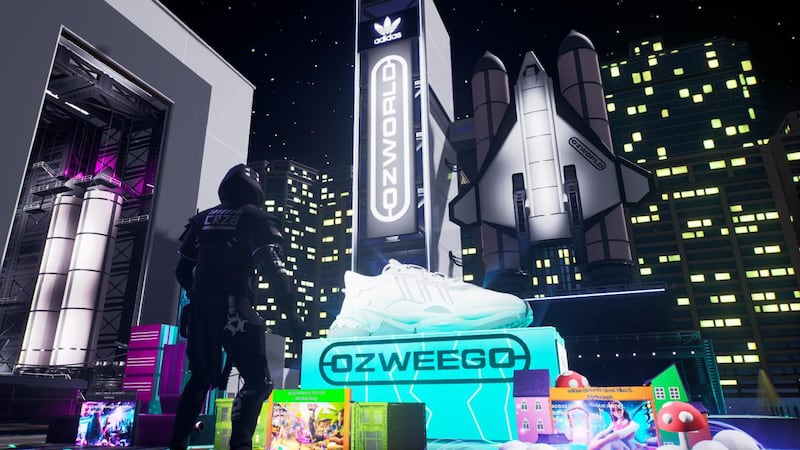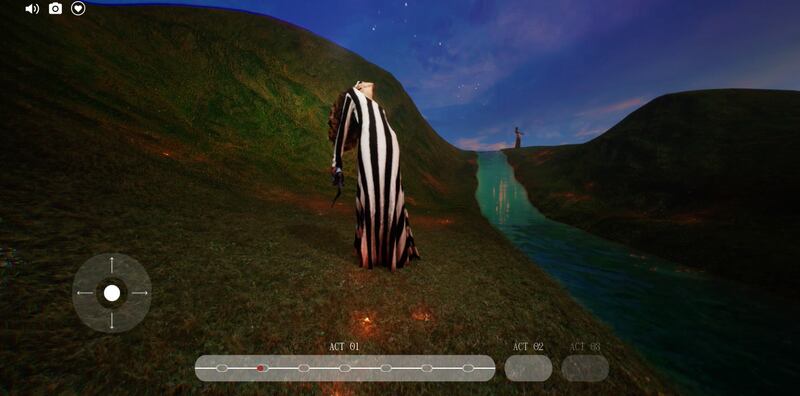
The Business of Fashion
Agenda-setting intelligence, analysis and advice for the global fashion community.

Agenda-setting intelligence, analysis and advice for the global fashion community.

To recreate Adidas’ Ozweego sneaker for the company’s new experience in Fortnite, it took BeyondCreative about four days. The studio, which specialises in building for the popular online game, can’t just import a 3D model into the space, explained Kasper Weber, its co-founder and chief executive. They have to assemble the digital replica out of an extensive library of simple shapes that Fortnite makes available to players to produce their own environments in its “creative” mode.
“We are building them out of circles, triangles, squares, half-circles, quarter-circles and different stuff,” Weber said. “It is a very niche craft.”
Even in the physical world, brands don’t construct their images alone. They rely on photographers, stylists, architects and others to help them shoot their ad campaigns, stage runway shows and design stores. But as more brands extend themselves into virtual environments such as video games and launch web3 projects like NFT collections, they’re leaning on a new generation of creatives skilled in fields such as 3D design, gaming and blockchain to translate their images into these digital spaces.
“There’s a huge opportunity for creativity in this world, not only at a technical software level but at a real creative level, particularly in our industry that as we know has specific tastes and aesthetic codes,” Massimiliano Di Battista, co-founder and chief executive of creative and talent agency MA + Group, which just launched its own metaverse division, recently told BoF.
ADVERTISEMENT

Prior to Adidas, BeyondCreative also worked with Balenciaga on the “Strange Times” hub it launched in Fortnite last year. Vans enlisted the help of studio The Gang to build its world in Roblox, while Gucci and Forever21 have teamed with Roblox creators like Rook Vanguard and cSapphire — winner of the British Fashion Council’s first award for metaverse design. Dior Beauty and Burberry, in partnership with Harrods, have both turned to Emperia to produce 3D environments for them, while Nike and 3.1 Phillip Lim have collaborated with the studio Superficial. The Dematerialised, a digital fashion brand, has produced NFTs for labels such as Karl Lagerfeld, Rebecca Minkoff and MCQ.
MA + Group and other creative agencies like Highsnobiety’s have also introduced their own web3 and metaverse divisions to support brands and connect them with the right talent when they want to launch projects.
For fashion brands, the aim is to capitalise on the opportunities appearing in digital spaces. Whether they’re doing that by marketing a physical product or racking up NFT sales, they’re seeking support from those with the expertise to bring their concepts to digital life.
Digital Craftsmanship
Part of what brands need from these digital talents is their technical abilities, like proficiency in 3D design, being able to build virtual avatars or knowing how to mint NFTs on a blockchain. But they may also need creative direction and guidance on how to create immersive experiences that enrich the stories around their products or image — services Superficial said its fashion clients seek from it.
There’s artistry involved in producing digital products or environments, too. 3D artists don’t just recreate physical spaces and items but also need to be able to capture what Marjorie Hernandez, co-founder of The Dematerialised, called the “intangibles” of a brand. That’s perhaps especially true when they’re creating a fantasy that doesn’t exist in the real world, such as the dream-like landscape FutureCorp made in collaboration with Marni to showcase the brand’s Spring/Summer 2022 collection.
“There is digital craftsmanship,” Hernandez said. “It’s not any different by the fact that you use a computer.”

Olga Dogadkina, co-founder and CEO of Emperia, said they begin each project with a proposal covering what the experience will look like as well as how it will feel for users and what the points of interaction will be. Before it began building its virtual experience for Dior Beauty’s pop-up this past holiday season, Emperia made sure it understood Dior’s core brand attributes, such as the colours it uses, the look and feel of its website and the different design elements of the pop-ups. The finished space incorporated all these pieces, including the flowers and trees present at Dior’s pop-ups, and set them in the midst of an astral backdrop that wouldn’t be possible in the physical world.
ADVERTISEMENT
“It’s a very high standard of quality people expect of those brands, regardless of where they’re experiencing it,” Dogadkina said.
That can present a challenge at times. Add too much detail and an online experience can slow down and become choppy if the user’s internet and computer aren’t fast enough. Some environments, such as the blockchain-based online world Decentraland, have basic graphics that can make it difficult for high-end brands to preserve their look within them. It’s a lesson that became clear during the first Metaverse Fashion Week.
While some virtual products and experiences will only be seen by a small number of users, others can be viewed by millions. To date, Vans World in Roblox has been visited more than 64 million times.
For an in-game experience like that, getting the gameplay right is crucial. The Gang worked with professional skateboarders to try to understand how it should feel for users to skate around the vast skatepark it helped build for Vans in Roblox, according to Marcus Holmström, co-founder and CEO of The Gang. (Vans told BoF it had kids test the game while it was in development, too, so they could get feedback.) Both he and Weber of BeyondCreative also talked about the importance of making sure an experience fits organically into a game and doesn’t come off as an obtrusive advertisement.
Often, in fact, one of the most valuable services digital creatives can provide is guidance to brands about what may work in a space. Dogadkina said when brands approach them they usually don’t have any experience with 3D environments. Jürgen Alker, head of Highsnobiety’s new NFT studio, said brands frequently come to them and ask, “What the heck should I do in the metaverse?”
Growing Demand
All the creatives and agencies BoF spoke to said the inquiries they’re receiving from fashion brands, and often companies generally, continue to rise.
“It’s been very high during this year,” Holmström said. “On average I would say that we get probably almost one per day, not from fashion brands but from companies around the world.” One recent project was a Formula 1 racing experience with McLaren to show off the automaker’s new car, the MCL36.
ADVERTISEMENT
Belinda Chen and Andrew Kupresanin, creative directors of Superficial, said in an email that fashion’s interest in entering virtual territories has grown exponentially in recent years and is only gathering momentum. Dogadkina said Emperia has seen interest in its services rising especially in the past three or four months.
Demand for digital creatives looks set to continue as more brands try to seize opportunities in 3D and web3 spaces. For someone like Weber, it’s led to a career he said he never expected for himself. He started designing gaming experiences as a teenager playing Minecraft and Counterstrike.
“My interest has always been developing user-generated content just for myself and my friends,” he said.
Now he does it for a living.
For more on technology, be sure not to miss the BoF Professional Summit: New Frontiers in Fashion and Technology on Wednesday, May 4 2022. Full access to the livestream is included with your BoF Professional Membership.
With the launch of a virtual world, the photographer offers a glimpse of how fashion creatives may unleash themselves in the metaverse.
Brands like Adidas, Gucci and The Hundreds are finding the tokens are a great way to reward their superfans. But maintaining that loyalty can be hard work.
Vans, Balenciaga and Benefit Cosmetics are among the brands tapping the multi-billion-dollar video gaming industry with strategies aimed at generating buzz and fostering community.

Marc Bain is Technology Correspondent at The Business of Fashion. He is based in New York and drives BoF’s coverage of technology and innovation, from start-ups to Big Tech.
The algorithms TikTok relies on for its operations are deemed core to ByteDance overall operations, which would make a sale of the app with algorithms highly unlikely.
The app, owned by TikTok parent company ByteDance, has been promising to help emerging US labels get started selling in China at the same time that TikTok stares down a ban by the US for its ties to China.
Zero10 offers digital solutions through AR mirrors, leveraged in-store and in window displays, to brands like Tommy Hilfiger and Coach. Co-founder and CEO George Yashin discusses the latest advancements in AR and how fashion companies can leverage the technology to boost consumer experiences via retail touchpoints and brand experiences.
Four years ago, when the Trump administration threatened to ban TikTok in the US, its Chinese parent company ByteDance Ltd. worked out a preliminary deal to sell the short video app’s business. Not this time.